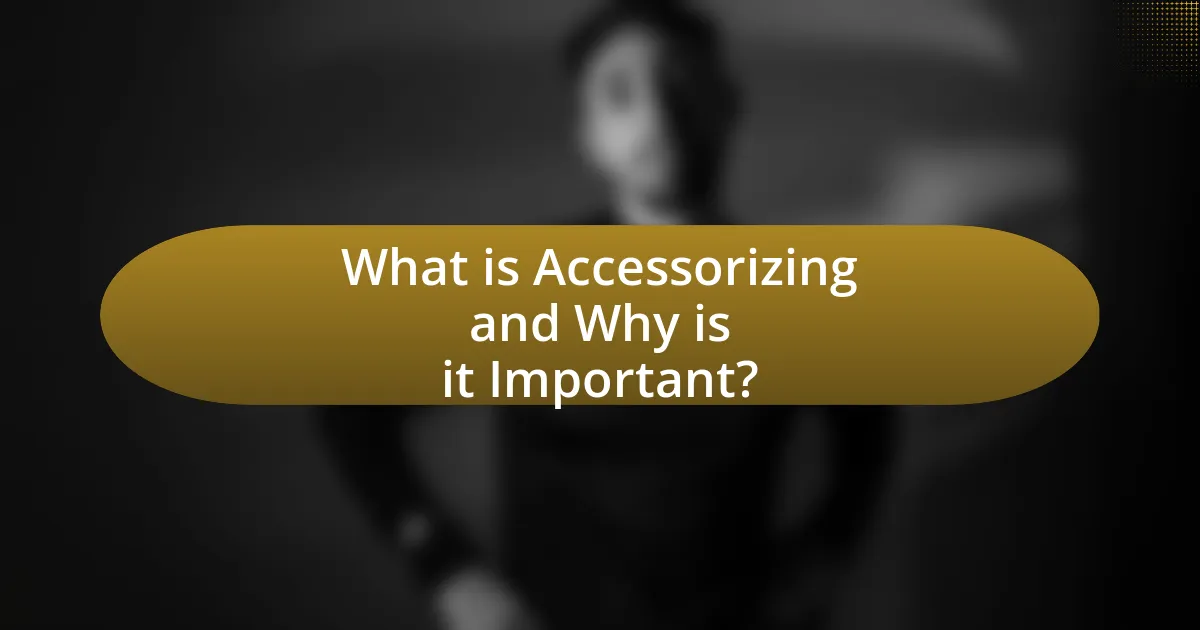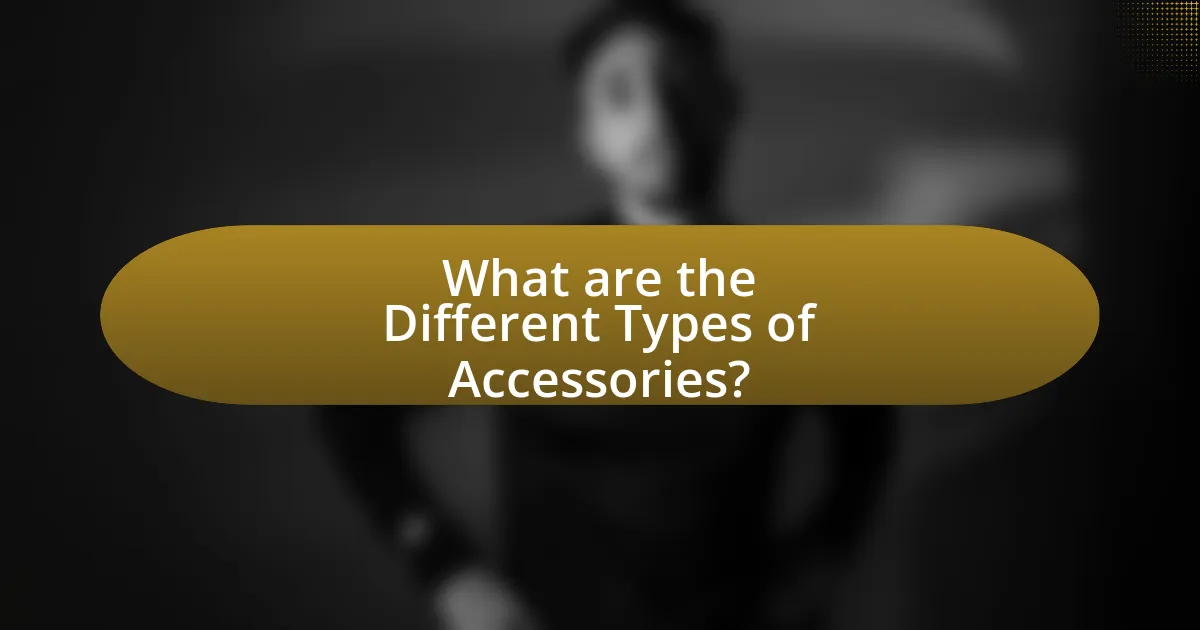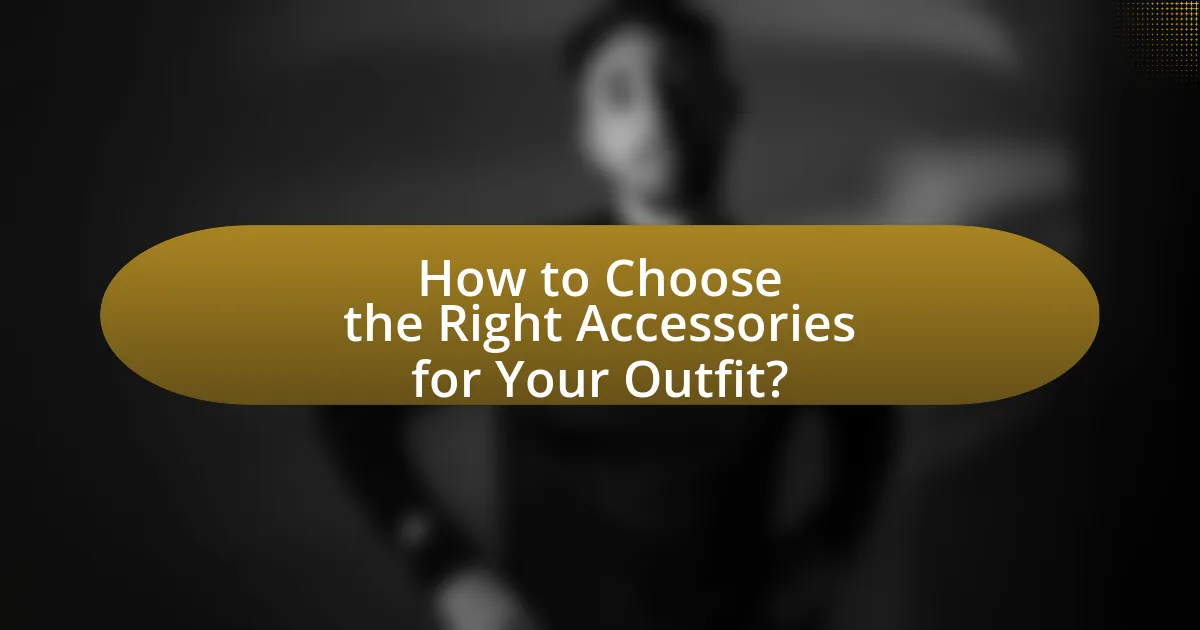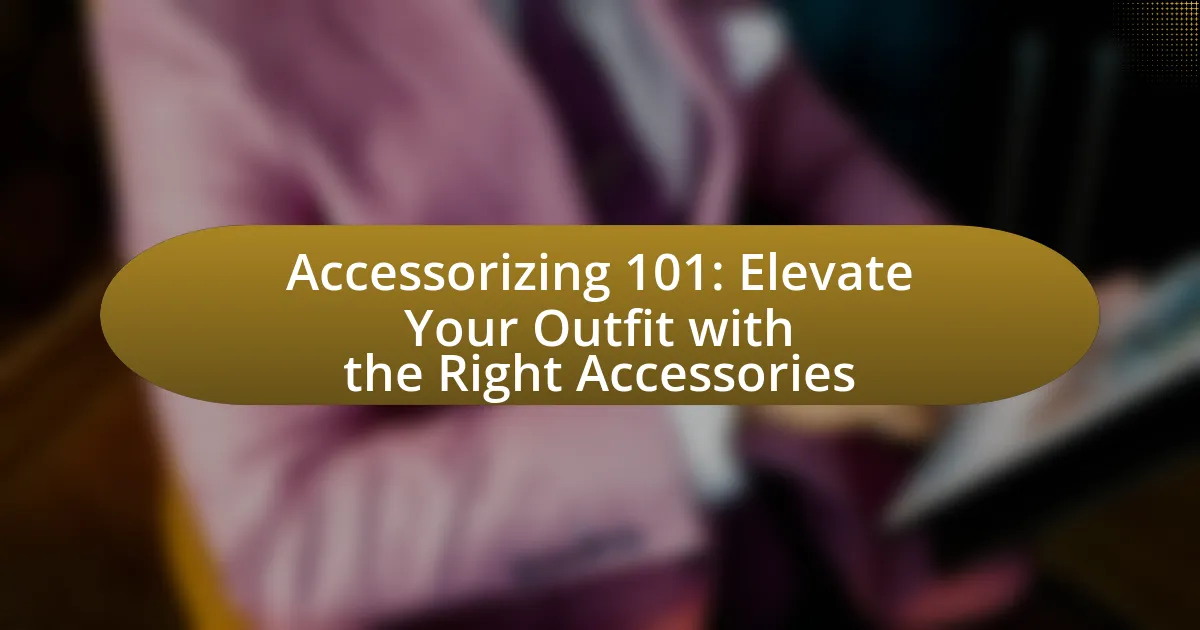Accessorizing is the practice of enhancing outfits with items such as jewelry, bags, belts, and scarves, which play a crucial role in personal style and overall aesthetic. This article explores how accessories can transform outfits, the various types commonly used in fashion, and their significance in reflecting personal style and influencing fashion trends. It also discusses the impact of seasonal trends on accessory choices, the importance of statement pieces, and practical tips for selecting and maintaining accessories effectively. Additionally, the article addresses common mistakes in accessorizing and offers guidance on developing a personal accessory style.

What is Accessorizing and Why is it Important?
Accessorizing is the practice of enhancing an outfit with additional items such as jewelry, bags, belts, and scarves to create a complete and polished look. It is important because accessories can significantly influence the overall aesthetic of an outfit, allowing individuals to express their personal style, add visual interest, and elevate even the simplest clothing choices. Studies show that well-chosen accessories can enhance confidence and make a positive impression, as they often serve as focal points that draw attention and convey personality.
How can accessories transform an outfit?
Accessories can significantly transform an outfit by adding visual interest, enhancing personal style, and providing functional benefits. For instance, a simple dress can be elevated with statement jewelry, a stylish belt, or a unique handbag, which can shift the outfit from casual to formal or from basic to chic. According to a study published in the Journal of Fashion Marketing and Management, accessories play a crucial role in consumer perception, influencing how outfits are viewed in terms of style and sophistication. This demonstrates that the right accessories not only complement clothing but also enhance the overall aesthetic and impact of an outfit.
What types of accessories are commonly used in fashion?
Commonly used accessories in fashion include jewelry, bags, belts, hats, scarves, and sunglasses. Jewelry, such as necklaces, earrings, and bracelets, enhances personal style and can signify status or occasion. Bags serve both functional and aesthetic purposes, with styles ranging from clutches to totes. Belts are used to define the waist and add structure to outfits. Hats provide protection from the elements while also serving as a fashion statement. Scarves can be worn in various ways to add color and texture, while sunglasses not only protect the eyes but also complete a look. Each accessory plays a significant role in elevating an outfit and expressing individual style.
How do accessories reflect personal style?
Accessories reflect personal style by serving as visual expressions of individual preferences and identity. They allow individuals to showcase their tastes, whether through bold statement pieces or subtle, minimalist items. For example, a person who favors vintage fashion may choose retro jewelry or handbags, while someone with a modern aesthetic might opt for sleek, contemporary designs. This choice of accessories can also indicate lifestyle, mood, and social status, as seen in the popularity of designer brands among certain demographics. Studies in fashion psychology suggest that accessories significantly influence first impressions, reinforcing the idea that they are crucial in conveying personal style.
What role do accessories play in fashion trends?
Accessories play a crucial role in fashion trends by enhancing and personalizing outfits. They serve as key elements that can transform a basic look into a statement ensemble, influencing overall style and aesthetic. For instance, a study by the Fashion Institute of Technology found that accessories can account for up to 30% of a consumer’s purchasing decision, highlighting their impact on fashion choices. Additionally, trends in accessories often dictate the direction of seasonal styles, as seen with the resurgence of statement jewelry and oversized bags in recent years, which reflect broader cultural shifts and consumer preferences.
How do seasonal trends influence accessory choices?
Seasonal trends significantly influence accessory choices by dictating the styles, colors, and materials that are popular at different times of the year. For instance, during spring and summer, lighter fabrics and vibrant colors are favored, leading to the popularity of accessories like straw hats and colorful sunglasses. In contrast, fall and winter trends often emphasize warmer materials and darker hues, resulting in the increased use of scarves, gloves, and statement jewelry made from heavier materials. This shift is supported by fashion industry reports, such as the annual trend forecasts from the Pantone Color Institute, which highlight how seasonal palettes affect consumer preferences and purchasing behavior.
Why are statement pieces significant in accessorizing?
Statement pieces are significant in accessorizing because they serve as focal points that enhance and elevate an outfit. By drawing attention, these bold accessories can transform a simple look into a stylish statement, allowing individuals to express their personal style and creativity. For instance, a striking necklace or oversized earrings can shift the entire aesthetic of an outfit, making it more visually appealing and memorable. This impact is supported by fashion industry trends, where designers often emphasize the importance of standout accessories in their collections, demonstrating their role in defining contemporary fashion.

What are the Different Types of Accessories?
The different types of accessories include jewelry, bags, belts, hats, scarves, watches, and eyewear. Jewelry encompasses items like necklaces, bracelets, and earrings, which enhance personal style. Bags serve both functional and aesthetic purposes, ranging from handbags to backpacks. Belts are used to secure clothing while adding a fashionable element. Hats can provide protection from the elements and serve as a style statement. Scarves offer warmth and can be styled in various ways. Watches are functional accessories that also convey personal style. Eyewear, including sunglasses and prescription glasses, combines utility with fashion. Each type of accessory plays a significant role in completing an outfit and expressing individual style.
What are the essential categories of accessories?
The essential categories of accessories include jewelry, bags, belts, hats, scarves, and eyewear. Jewelry encompasses items like necklaces, bracelets, and earrings, which enhance personal style. Bags serve both functional and aesthetic purposes, ranging from handbags to backpacks. Belts are used to secure clothing while adding a decorative element. Hats provide protection from the elements and can be fashion statements. Scarves offer warmth and style versatility. Eyewear, including sunglasses and prescription glasses, combines functionality with fashion. Each category plays a crucial role in completing and elevating an outfit.
How do jewelry pieces enhance an outfit?
Jewelry pieces enhance an outfit by adding visual interest, personal style, and a touch of elegance. They serve as focal points that can draw attention to specific areas, such as the neckline or wrists, thereby complementing the overall look. For instance, a statement necklace can transform a simple dress into a more sophisticated ensemble, while earrings can frame the face and highlight features. Studies show that accessorizing with jewelry can increase perceived attractiveness and confidence, as individuals often feel more put-together when wearing well-chosen accessories.
What function do bags serve beyond style?
Bags serve multiple functions beyond style, primarily including utility, organization, and convenience. They provide a means to carry personal items such as wallets, phones, and keys, ensuring that essentials are easily accessible. Additionally, bags help in organizing belongings, with various compartments designed for specific items, which enhances efficiency in daily activities. For instance, a backpack can distribute weight evenly, making it easier to transport heavier loads, while a tote bag allows for quick access to items during errands. These practical aspects of bags are essential for modern lifestyles, where mobility and organization are key.
How do footwear choices impact overall accessorizing?
Footwear choices significantly impact overall accessorizing by influencing the visual harmony and style coherence of an outfit. The type of shoes selected—whether casual sneakers, elegant heels, or rugged boots—determines the appropriate accessories that complement the look. For instance, pairing formal shoes with sophisticated jewelry and a structured handbag enhances a polished appearance, while casual footwear allows for more playful accessories like colorful bags or statement earrings. Studies in fashion psychology indicate that footwear can affect perceptions of style and confidence, further emphasizing the importance of aligning shoe choices with accessories to create a cohesive aesthetic.
What types of shoes are best for different occasions?
For formal occasions, dress shoes such as oxfords or loafers are best, as they provide a polished look suitable for events like weddings or business meetings. For casual outings, sneakers or loafers are ideal, offering comfort and style for activities like brunch or shopping. For outdoor events, sandals or hiking shoes are recommended, ensuring comfort and support during activities like picnics or hikes. Lastly, for athletic activities, specialized sports shoes like running shoes or cross-trainers are essential, as they provide the necessary support and cushioning for performance. Each type of shoe is designed to meet the specific demands of the occasion, enhancing both functionality and style.
How can shoes complement or clash with accessories?
Shoes can complement or clash with accessories based on their color, style, and material. When shoes match the color palette or style of accessories, such as handbags or jewelry, they create a cohesive look that enhances the overall outfit. For example, pairing black leather shoes with a black leather handbag establishes a unified aesthetic. Conversely, shoes can clash with accessories if there is a significant mismatch in style or color, such as wearing casual sneakers with formal attire and elegant accessories, which disrupts the intended sophistication of the outfit. This principle is supported by fashion guidelines that emphasize harmony in color and style for a polished appearance.

How to Choose the Right Accessories for Your Outfit?
To choose the right accessories for your outfit, first consider the overall style and color scheme of your clothing. Accessories should complement your outfit rather than clash with it; for instance, if you wear a bold patterned dress, opt for simpler accessories to avoid overwhelming the look. Additionally, consider the occasion; formal events typically require more elegant accessories, while casual outings allow for playful or trendy pieces. According to fashion experts, matching the metal tones of jewelry with other accessories, such as belts and shoes, creates a cohesive look.
What factors should you consider when selecting accessories?
When selecting accessories, consider factors such as personal style, occasion, color coordination, and functionality. Personal style influences the types of accessories that resonate with an individual, ensuring that choices reflect their unique identity. The occasion dictates the appropriateness of certain accessories; for example, formal events may require elegant pieces, while casual outings allow for more playful options. Color coordination is essential for creating a cohesive look, as accessories should complement the outfit’s color palette. Lastly, functionality is important; accessories should serve a purpose, such as a bag for carrying essentials or jewelry that enhances the overall aesthetic. These factors collectively guide effective accessory selection, enhancing the overall outfit.
How does the occasion influence accessory selection?
The occasion significantly influences accessory selection by dictating the formality, style, and purpose of the accessories chosen. For instance, formal events such as weddings or galas typically require elegant accessories like statement jewelry and sophisticated clutches, while casual outings may call for simpler, more relaxed items like crossbody bags and minimalistic jewelry. This alignment ensures that the accessories complement the overall outfit and adhere to social norms associated with the specific occasion, enhancing the wearer’s appearance and confidence.
What role does color coordination play in accessorizing?
Color coordination is essential in accessorizing as it enhances the overall aesthetic of an outfit. By ensuring that accessories complement or contrast effectively with clothing colors, individuals can create a cohesive and visually appealing look. Studies in color theory indicate that harmonious color combinations can evoke specific emotions and perceptions, influencing how an outfit is received. For instance, using a color wheel, one can identify complementary colors that, when paired, create a striking visual impact, thereby elevating the overall style.
How can you mix and match accessories effectively?
To mix and match accessories effectively, choose a cohesive color palette and varying textures to create visual interest. For instance, pairing a chunky knit scarf with a sleek leather handbag can add depth to an outfit. Additionally, consider the scale of accessories; larger pieces can be balanced with smaller ones to avoid overwhelming the look. According to fashion experts, such as those from the Council of Fashion Designers of America, successful accessorizing often hinges on balancing statement pieces with more subtle items, ensuring that no single accessory dominates the overall appearance.
What are the guidelines for layering accessories?
Layering accessories involves combining multiple pieces to enhance an outfit while maintaining balance and cohesion. To effectively layer accessories, start with a focal piece, such as a statement necklace or bold earrings, and build around it with complementary items like bracelets or rings. Ensure that the colors and materials of the accessories harmonize; for instance, mixing metals can create a modern look, while sticking to one metal type can provide a classic feel. Additionally, vary the lengths and sizes of the accessories to create visual interest; for example, pairing a long pendant necklace with shorter layered chains can add depth. Finally, consider the occasion and outfit style; casual outfits may benefit from playful accessories, while formal attire may require more understated elegance.
How can you balance bold and subtle accessories?
To balance bold and subtle accessories, combine one statement piece with understated items. For example, if wearing a large, colorful necklace, opt for simple stud earrings and a minimalist bracelet. This approach ensures that the bold accessory remains the focal point while the subtle pieces complement without competing. Fashion experts recommend this method as it creates visual harmony and prevents overwhelming the outfit.
What are some common mistakes to avoid in accessorizing?
Common mistakes to avoid in accessorizing include over-accessorizing, which can overwhelm an outfit and create visual clutter. Choosing accessories that clash in style or color with the outfit can also detract from the overall look. Additionally, neglecting to consider the occasion can lead to inappropriate choices, such as wearing overly casual accessories to a formal event. Lastly, failing to balance proportions, such as pairing large accessories with a busy outfit, can disrupt the visual harmony. These mistakes can diminish the intended impact of accessorizing, making it essential to choose thoughtfully.
How can over-accessorizing detract from an outfit?
Over-accessorizing can detract from an outfit by overwhelming the overall look and drawing attention away from the clothing itself. When too many accessories are worn, they can create visual clutter, making it difficult for the observer to focus on any single element of the outfit. This phenomenon is supported by fashion principles that emphasize balance and harmony; for instance, the rule of thumb in styling suggests that one should aim for a maximum of three statement accessories to maintain a cohesive appearance.
What are the signs of mismatched accessories?
Signs of mismatched accessories include clashing colors, incompatible styles, and disproportionate sizes. Clashing colors occur when accessories do not complement each other or the outfit, leading to a visually jarring appearance. Incompatible styles arise when accessories from different fashion genres, such as pairing casual items with formal ones, create a disjointed look. Disproportionate sizes can be evident when accessories are either too large or too small compared to the outfit, disrupting the overall balance. These signs indicate that the accessories do not harmonize, which can detract from the intended aesthetic of the outfit.
What are some practical tips for accessorizing like a pro?
To accessorize like a pro, focus on balance, layering, and personal style. First, ensure that your accessories complement your outfit without overwhelming it; for example, if wearing bold clothing, opt for subtle accessories. Layering different types of accessories, such as necklaces or bracelets, can add depth and interest to your look, but maintain a cohesive color palette to avoid clashing. Additionally, choose accessories that reflect your personal style and enhance your confidence, as this authenticity will elevate your overall appearance.
How can you develop your own accessory style?
To develop your own accessory style, start by identifying your personal aesthetic and preferences. This involves assessing your wardrobe, understanding what colors, materials, and shapes resonate with you, and experimenting with different accessories to see what complements your outfits. Research shows that personal style is often influenced by factors such as lifestyle, body shape, and cultural background, which can guide your accessory choices. By curating a collection of accessories that reflect your individuality, you can create a signature look that enhances your overall appearance.
What are the best practices for maintaining your accessories?
To maintain your accessories effectively, regularly clean them according to their material specifications. For example, metal accessories should be polished with a soft cloth to prevent tarnishing, while leather items require conditioning to avoid drying and cracking. Additionally, store accessories in a cool, dry place, ideally in individual pouches or boxes to prevent scratches and tangling. This practice is supported by the fact that proper storage can extend the lifespan of accessories significantly, as noted in studies on material preservation. Regularly inspecting accessories for signs of wear or damage allows for timely repairs, ensuring they remain in good condition.

Leave a Reply